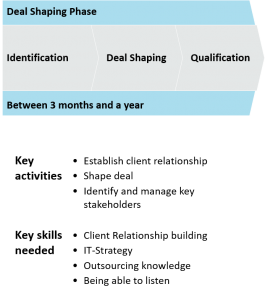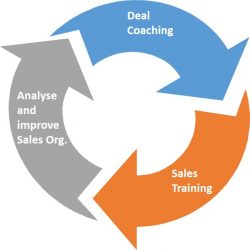Every Deal needs a clear owner who takes up the deal as early as possible, and then drives it towards closure. Without this one person who makes it his personal mission to win the deal, the chances of winning will be substantially lower. Looking at the different phases of a deal, there are different skills needed to move the deal from one phase to the next and stay ahead of the competition. During each phase it is up to the deal owner to align and also orchestrate with his team and other stakeholders to ensure the deal stays on course.
Each deal will move through those key phases:
- Identification / Opportunity generation
- Deal Shaping
- Qualification / RFI phase
- Proposal / Bid phase
- Down selection
- Contract negotiation
- Closing and start of delivery / transition

Let’s have a detailed look at the role of the Deal Owner in those phases:
during the Identification, the deal owner gets the first information about the deal, ideally from a coworker who is attached to the account this deal is coming from. Ideally, this is the account lead, who is regularly talking to his C-Level counterpart. The deal owner then needs to make a quick assessment if the scenario as described is interesting enough to start working on. Ideally, he will discuss with the account lead how to do a follow up discussion with the client to talk about an initial scope, and mainly the underlying strategy and motivation of the client to consider such a deal. Another start into a deal can also be an account planning session where a particular client is identified as a target account for a large strategic deal. In those cases the deal owner needs to be part of the account planning session and then have some initial meetings and workshops with the account team in oder to prepare the messages for the initial client meetings.
In a next step, the deal owner will then have first meetings with the client and start to shape the deal – specify the scope, segregate the different towers, and also gather some strategic requirements and goals that should be reached with this deal. He will explain to the client the different options and deal shapes. During this phase the deal owner needs to act as a partner to the client who can help him clarify his thoughts on the opportunity, and who also establishes a deep relationship as a trusted advisor, being able to talk to the client about their overall strategy and in particular their IT-Strategy.

Once the deal shape and the scope are clear to all involved parties, a more formal RFI / RFP phase will start. During that phase the deal owner has to fulfil two roles: on the one side, he needs to start working with the senior management team in order to properly qualify the deal, get the needed resources to work on the bid, and also to get the management buy in for this opportunity. A well defined and executed qualification process is mandatory to ensure that work and effort is spent on the right deals – those that can be won. There are only a few cases where participation in a deal without a realistic win chance is justified. On the other side, he needs to assemble and lead the deal team. For a complex deal such a team can easily consist of 20 -30 persons, sometimes even more. The deal owner needs to structure the team into the different solution towers and other work streams like legal and commercial (There will be a separate Blog entry on the different roles in a large deal). He will act as the overall project or program lead during this phase. Further, he needs to take up responsibility that the solution team does not only deliver the standard solutions, instead he needs to create the USP’s that will be essential to sell the deal to the client in a competitive environment. There are essentially two highlights during this phase where the deal owner is responsible for the overall quality – first the proposal document that needs to be delivered according to the expectations and schedule of the client, and second the proposal presentation where the deal owner does not only need to shape the story line of the presentation, but he also needs to ensure that all participants know precisely what their part in this story is going to be, and how to present this to the client as an integrated team. (There will be a separate Blog entry on Team Selling focusing on proposal presentations)

Continue reading “Taking Ownership of a Deal – The Pursuit Lead”

